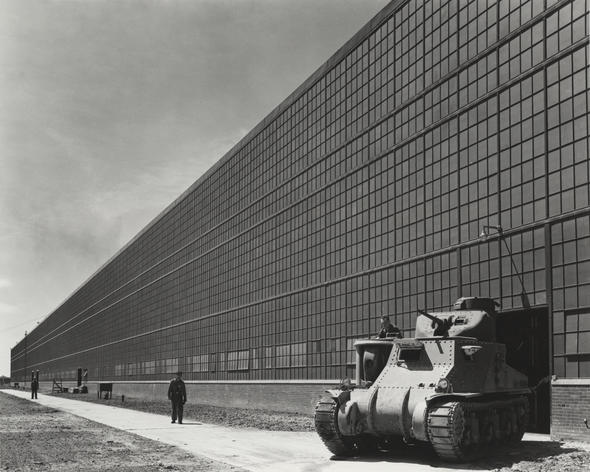The Architecture of War at the CCA

Chrysler Tank Arsenal, Warren township, by Albert Kahn Associates and Chrysler Corporation, 1941. Photograph by Hedrich-Blessing. © Chicago History Museum, HB-06539-C
When you think of the second World War, genocide and destruction probably come to mind. But many of us tend to forget about the architectural innovations that took place during this part of history; in fact, construction and development are crucial aspects of warfare. This is exactly what the Canadian Centre for Architecture attempts to show in its new exhibit, titled "Architecture in Uniform: Designing and Building for the Second World War."
From the destruction of Guernica in 1937 to the American bombing of Hiroshima and Nagasaki in 1945, viewers are able to interact with multiple innovations made in the realm of architecture through a series of galleries focused on different aspects of warfare.
Jean-Louis Cohen, the exhibit's lead curator and the Sheldon H. Solow Chair for the History of Architecture at the New York institute of Fine Arts, brings together an impressive amount of maps, sketches, artifacts and pictures from famed museums like Moscow's Schusev State Museum of Architecture and the Deutsches Architekturmuseum in Frankfurt. And a partnership with the National Film Board of Canada takes the presentation to another level, by allowing people to take part in audio-visual exhibits throughout the entire museum.
Though budget and space constraints may have limited Cohen's efforts, the exhibit offers a look at the planning of office and factory spaces for the purpose of production and protection during wartime.
The first three galleries take on the heavy task: discussing the propaganda and preparation required for countries at war. Among many subjects discussed in the exhibit's early stages, the replacement of typical iron household items by glass objects leads way to a major turning point in the history of architecture: the development of mass-production towns.
Civil engineers and architects worked hard at removing large factories from established cities in order to protect the population from imminent dangers. The construction of Albert Kahn Associates' Chrystler Tank Arsenal and Ford Motor Bomber Plant in Michigan marked a new beginning for architectural strategies and productivity.
Along with positive developments in industrial building and city planning came what Cohen called the "dark side" of architecture. While the Allied countries found ways to protect their economical and social assets, architects took part in the construction of Auschwitz, a concentration camp integrated within an urban plan. In North America, architecture firm Skidmore, Owings and Merrill, helped make Oak Ridge, a secret city in Tennessee that housed nearly 75,000 employees working at nuclear facilities. The exhibit makes a point of focusing on the moral, social and political dilemmas of architects working under extreme pressure.
"Architecture in Uniform" is easy to follow and visually appealing. The exhibit closes on a high note, by presenting the post-war world and the impressive development of modernist architecture. From the opening of markets for the mass consumption of war-produced items to exposing the ideals of a post-war world, Cohen has made it easy for everyone to follow the ever-changing anatomy of design.
Not unlike the plans and sketches for post-war victory buildings shown in the last gallery, Cohen could easily consider this exhibit his very own pavilion of pride and achievement.
"Architecture in Uniform: Designing and Building for the Second World War" takes place at the Canadian Centre for Architecture between April 14 and September 18. The National Film Board of Canada will also offer special screenings of curated propaganda films titled Wartime Cinema at the Paul-Desmarais Theatre.
For more information, visit the CCA's website.
(Follow Mick on Twitter.)
Related on maisonneuve.org:
—The Composer Who Used Coloured Pencils
—Journeys at the CCA: The Architecture of Migration
—Interview with Witold Rybczynski Subscribe — Follow Maisy on Twitter — Like Maisy on Facebook





